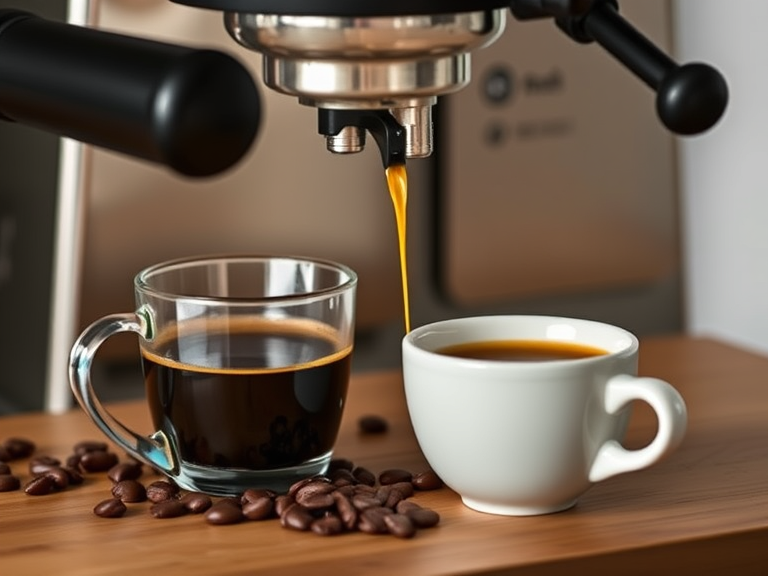Making the perfect cup of coffee requires understanding the delicate balance between coffee and water. Getting this ratio right is crucial for achieving the optimal flavor and strength in your brew.
Also Read: Coffee To Water Ratios: How To Measure Coffee Like A Pro
Let’s dive into everything you need to know about coffee-to-water ratios and measuring techniques.
Understanding Coffee-to-Water Ratios Basics
The coffee-to-water ratio is simply the relationship between the amount of coffee grounds and water used in brewing. This ratio significantly impacts the taste, strength, and overall quality of your coffee. Professional baristas typically measure these ratios by weight rather than volume for more accurate results.
The Golden Ratio
The widely accepted golden ratio for coffee brewing is 1:16 to 1:18. This means using one part coffee to sixteen or eighteen parts water. For example, if you use 15 grams of coffee grounds, you would use 240-270 grams of water. This ratio produces a well-balanced cup that most coffee drinkers enjoy.
Different Methods and Their Ideal Ratios

Pour-Over Coffee
Pour-over brewing works best with a ratio between 1:15 and 1:17. This method requires careful attention to pouring technique and timing. Using 20 grams of coffee with 300-340 grams of water creates a clean, flavorful cup that highlights the coffee’s subtle notes.
French Press
French press coffee typically uses a stronger ratio of 1:12 to 1:14. The coarser grind and full immersion brewing style benefit from this higher concentration. For a standard 32-ounce French press, use about 54 grams of coffee to 650 grams of water.
Espresso
Espresso has a much more concentrated ratio, typically around 1:2. This means using 18 grams of finely ground coffee to produce about 36 grams of espresso. The high pressure and short extraction time require this concentrated ratio.
Cold Brew
Cold brew coffee uses the most concentrated ratio, usually 1:4 or 1:5. This stronger ratio compensates for the cold extraction process and creates a concentrated brew that can be diluted with water or milk.
Essential Tools for Measuring

Digital Scale
A digital scale is the most accurate tool for measuring both coffee and water. Look for scales with 0.1-gram precision and a built-in timer for even better brewing control.
Coffee Scoop
While less precise than a scale, a coffee scoop can work for casual brewing. One standard coffee scoop typically holds about 10 grams of coffee grounds.
Measuring Cup
For water measurement when a scale isn’t available, use a measuring cup. Remember that one milliliter of water equals one gram.
Common Mistakes to Avoid
Eyeballing Measurements
Guessing amounts leads to inconsistent results. Always measure your coffee and water for the best results.
Ignoring Coffee Bean Type
Different coffee beans have different densities. Dark roasts are less dense than light roasts, so they require slightly different ratios.
Using the Wrong Water Temperature
Water temperature affects extraction. Use water between 195-205°F (90-96°C) for optimal results.
Tips for Perfect Measurements
- Use a timer along with your measurements to ensure consistent extraction time
- Keep notes of your preferred ratios for different brewing methods
- Clean your measuring tools regularly for accurate results
- Consider humidity and temperature effects on coffee grounds
Adjusting Ratios for Taste

Stronger Coffee
For stronger coffee, use a ratio with more coffee, like 1:15. This increases the concentration while maintaining proper extraction.
Milder Coffee
For milder coffee, try a ratio of 1:18 or even 1:19. This creates a lighter brew while still extracting enough flavor.
Personal Preference
Remember that these ratios are starting points. Adjust them based on your taste preferences and the specific coffee beans you’re using.
Water Quality and Its Impact
Using quality water significantly affects your coffee’s taste. Filtered water free from strong mineral content or chlorine produces the best results. The water’s mineral content can impact extraction and final flavor.
Brewing for Different Serving Sizes
Single Cup
For one 8-ounce cup, use 15 grams of coffee to 240 grams of water.
Full Pot
For a 12-cup pot, use about 90 grams of coffee to 1440 grams of water.
Travel Mug
For a 16-ounce travel mug, use 30 grams of coffee to 480 grams of water.
Specialty Coffee Considerations

Specialty coffee often requires more precise ratios to highlight unique flavor profiles. Single-origin beans may need specific ratios to bring out their characteristic tastes. Consider adjusting your ratio based on the coffee’s origin and roast level.
Storage and Freshness
Proper storage affects coffee weight and measurement accuracy. Store beans in an airtight container away from light and heat. Grind just before brewing for the most accurate measurements and best flavor.
Professional Barista Techniques
Distribution
Even the distribution of coffee grounds ensures uniform extraction. Use techniques like WDT (Weiss Distribution Technique) for espresso or gentle shaking for filter coffee.
Timing
Professional baristas time their extractions precisely. Different ratios may require different extraction times for optimal results.
Seasonal Adjustments
Coffee brewing might need slight ratio adjustments based on seasons. Humidity and temperature can affect both coffee grounds and extraction. Consider using slightly different ratios in summer versus winter.
Equipment Maintenance
Regular cleaning and calibration of measuring equipment ensure accurate ratios. Check your scale’s accuracy periodically and keep brewing equipment clean for consistent results.
Economic Considerations
Using proper ratios can save money by preventing waste. Measuring accurately helps you use exactly what you need without excess.
Environmental Impact
Precise measurements reduce coffee waste and water usage. This attention to detail makes your coffee brewing more environmentally friendly.
Frequently Asked Questions
How much coffee do I need for 8 cups of water?
Use about 60 grams of coffee for 8 cups (1.2 liters) of water.
Should I measure differently for dark and light roasts?
Yes, use slightly more dark roast by volume as it’s less dense than light roast.
Can I use the same ratio for hot and cold brew?
No, cold brew requires a more concentrated ratio, typically 1:4 or 1:5.
How do I adjust ratios for altitude?
Higher altitudes may require slightly more coffee due to lower boiling points.
Does grind size affect the coffee-to-water ratio?
Finer grinds typically extract more quickly and may need less coffee.
Conclusion
Mastering coffee-to-water ratios is essential for consistently great coffee. Start with the standard 1:16 ratio and adjust based on your preferences and brewing method.
Also Read: Coffee To Water Ratios: How To Measure Coffee Like A Pro
Remember that precision in measurement leads to better results, but don’t be afraid to experiment within reasonable ranges to find your perfect cup.
Keep notes of your successful ratios, and consider the many variables affecting your brew. With practice and attention to detail, you’ll be measuring coffee like a professional barista in no time.
Remember that while these guidelines provide a solid foundation, the best coffee is the one that tastes right to you.
Use these ratios as starting points and adjust them to match your taste preferences. Happy brewing!
The science of coffee-to-water ratios might initially seem complex, but with understanding and practice, it becomes second nature.
Whether you’re a home enthusiast or an aspiring professional, proper measurement techniques will elevate your coffee game significantly. Embrace the precision, enjoy the process, and savor the results of your perfectly measured coffee.

